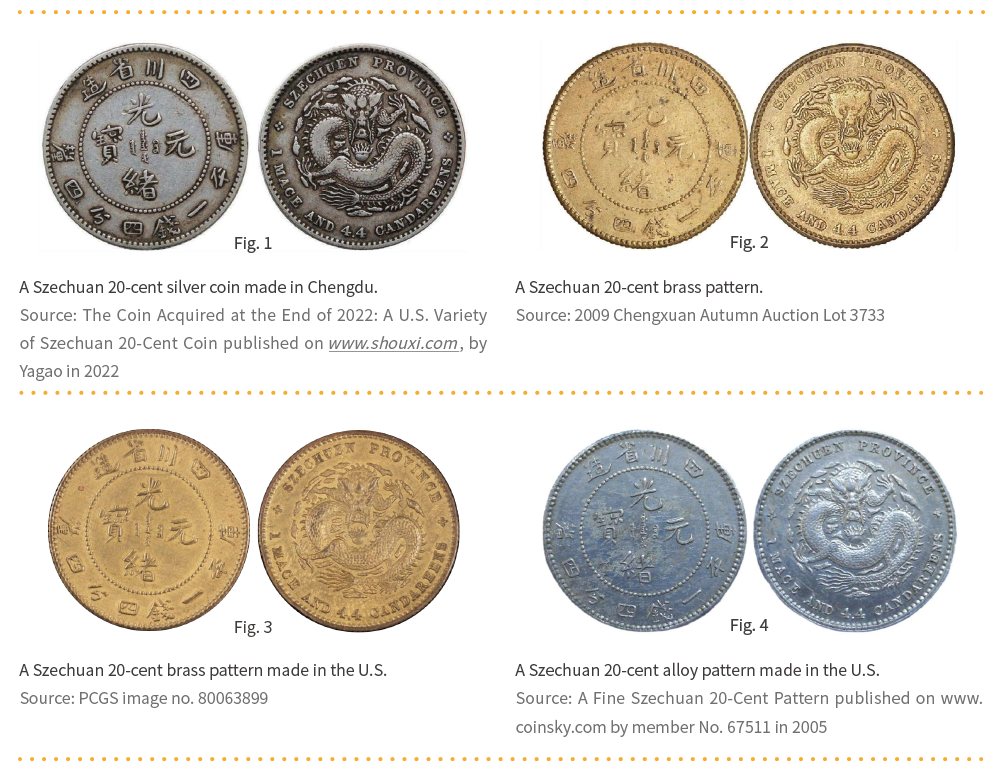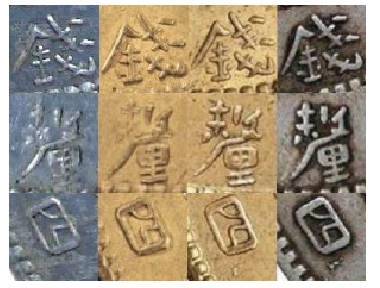I have been collecting Szechuan 20-cent dragon coins for a long time (all Szechuan 20-cent dragon coins and patterns mentioned in this article are the Er Bao爾寶variety), and recently I acquired a rare U.S. variety (Fig. 1). I did not have a chance to examine it closely before, but now, we can take a closer look at it. Through multiple comparisons, I found it is a hitherto unmentioned U.S. variety brass pattern made by the Chengdu Mint, and I have finally clarified the relationship between different kinds of patterns.
It all starts with a small episode when the Chengdu Mint was built.
The Chengdu Mint was approved to be built by the Qing government in 1896 and purchased minting equipment from the U.S. Ferracute Machine Company through American Trading Company. The machines were shipped from the U.S. to China in the beginning of the second year. When these machines were shipped to Yichang, they underwent flooding and were under water for six weeks, causing severe rusting of machines and coin dies. It was not until the middle of 1898 that the Chengdu Mint began to produce coins on a trial basis.
In 2009, the Beijing Chengxuan Autumn Auction sold a Szechuan 20-cent dragon brass pattern (Fig. 2), which was obviously weakly struck. The upper part of the character "光" is almost invisible, and most scales on the dragon head and body are gone. At first glance, I thought it was general wear and tear, but in fact it was a seriously weak strike due to insufficient machine pressure during the pressing.
Compared to a Szechuan brass pattern (Fig. 3) and an alloy pattern made in the U.S. (Fig. 4) shown on the PCGS website, both of which are quite fine. Both sides of these patterns are sharply struck, the characters and patterns are full, and the dragon scales are clear and complete with a strong relief. All these are in line with the style of the pattern coins. However, there are two places that caught my attention. They are the characters "錢" and "厘" in "庫平一錢四分四釐" (20-cent).
The two dots to the left and right of the lower part of the character "錢" seem to be weak; The lower part of the upper left end of the character "厘" is also weak. Through a careful comparison of several other Szechuan brass patterns shown on the PCGS website, these two parts are not so clear as on some patterns, including the one kept in the Ferracute archive. However, all other strokes are as deep as a knife cut.
As for the one from the Chengxuan Auction, I found that the strokes of both characters were complete, with no traces of a weak strike. I wonder why those two places of other sharply struck patterns are weak too, while this one has a large space of weak striking, except those two locations.
It all starts with a small episode when the Chengdu Mint was built.
The Chengdu Mint was approved to be built by the Qing government in 1896 and purchased minting equipment from the U.S. Ferracute Machine Company through American Trading Company. The machines were shipped from the U.S. to China in the beginning of the second year. When these machines were shipped to Yichang, they underwent flooding and were under water for six weeks, causing severe rusting of machines and coin dies. It was not until the middle of 1898 that the Chengdu Mint began to produce coins on a trial basis.
In 2009, the Beijing Chengxuan Autumn Auction sold a Szechuan 20-cent dragon brass pattern (Fig. 2), which was obviously weakly struck. The upper part of the character "光" is almost invisible, and most scales on the dragon head and body are gone. At first glance, I thought it was general wear and tear, but in fact it was a seriously weak strike due to insufficient machine pressure during the pressing.
Compared to a Szechuan brass pattern (Fig. 3) and an alloy pattern made in the U.S. (Fig. 4) shown on the PCGS website, both of which are quite fine. Both sides of these patterns are sharply struck, the characters and patterns are full, and the dragon scales are clear and complete with a strong relief. All these are in line with the style of the pattern coins. However, there are two places that caught my attention. They are the characters "錢" and "厘" in "庫平一錢四分四釐" (20-cent).
The two dots to the left and right of the lower part of the character "錢" seem to be weak; The lower part of the upper left end of the character "厘" is also weak. Through a careful comparison of several other Szechuan brass patterns shown on the PCGS website, these two parts are not so clear as on some patterns, including the one kept in the Ferracute archive. However, all other strokes are as deep as a knife cut.
As for the one from the Chengxuan Auction, I found that the strokes of both characters were complete, with no traces of a weak strike. I wonder why those two places of other sharply struck patterns are weak too, while this one has a large space of weak striking, except those two locations.

With this question in mind, I took a closer look at this U.S. variety Szechuan 20-cent dragon pattern in my collection. After careful comparison, I found that two patterns made in the U.S. have no weak strike in the two positions like the one from the Chengxuan Auction. Besides, the one from the Chengxuan Auction and the U.S. variety patterns have a common feature, that is, there are some bumps of different sizes on the blank to the right of the character "四" (Fig. 5). This feature is not found in other sharply struck Szechuan brass patterns. Through this feature, it can be determined that the one from the 2009 Chengxuan Auction and the U.S. variety patterns were made by the same die. Other several brass patterns deeply struck but with defective strokes were made by a different die. It can also be seen that the two dies have a sequential relationship. They both have a ring of 85 beads on the obverse and the number of edge teeth on either side is 113. From these characteristics, it can be inferred that the die of the brass pattern struck with sufficient pressure and defective strokes should be the previous one, while the die used to produce the pattern sold at the 2009 Chengxuan Auction and the U.S. variety was produced after the strokes were trimmed on the basis of this previous die. At the same time, it occurred to me that the bumps below the character "四" were due to the rusting of the coin dies when the machines and dies were left flooded by the river for six weeks when they were transported to Yichang. These bumps are most likely the marks left by rust on the die. The rust on the die also led to the pits on the coins produced later. Therefore, the patterns with flat blanks were produced before those with pitted blanks. It also explains the reason why the brass pattern sold on the 2009 Chengxuan Auction is obviously weakly struck, that is, the die was tested on the machine after being modified in Chengdu, and the insufficient pressure during the testing process caused the weak strike of the pattern. Therefore, this one is the U.S. variety brass pattern made in Chengdu. Finally, the U.S. variety silver coin was pressed by using silver blanks after the testing was made.

From left to right: the alloy pattern made in the U.S., the brass pattern made in the U.S.,
the brass pattern made in Chengdu, and the silver coin made in Chengdu
In summary, the relationship between above several Szechuan 20-cent dragon patterns coin can be listed as follows.
